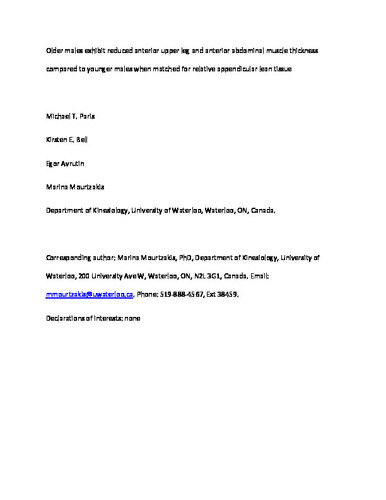| dc.contributor.author | Paris, Michael | |
| dc.contributor.author | Bell, Kirsten Elizabeth | |
| dc.contributor.author | Avrutin, Egor | |
| dc.contributor.author | Mourtzakis, Marina | |
| dc.date.accessioned | 2023-05-10 13:49:35 (GMT) | |
| dc.date.available | 2023-05-10 13:49:35 (GMT) | |
| dc.date.issued | 2021-10 | |
| dc.identifier.uri | https://doi.org/10.1016/j.archger.2021.104483 | |
| dc.identifier.uri | http://hdl.handle.net/10012/19434 | |
| dc.description | The final publication is available at Elsevier via https://doi.org/10.1016/j.archger.2021.104483. © 2021. This manuscript version is made available under the CC-BY-NC-ND 4.0 license http://creativecommons.org/licenses/by-nc-nd/4.0/ | en |
| dc.description.abstract | Background Ageing-related muscle atrophy does not occur uniformly across the body; rather, atrophy occurs to a greater extent in specific muscle groups compared to others. However, site-specific comparisons of muscle mass between older and younger adults typically do not account for relative muscle mass (i.e., matched for age- and sex-specific percentiles), which may confound site-specific differences. Furthermore, the uniformity of ageing-related differences in muscle composition (e.g., intramuscular adipose tissue) across the body are not well characterized. Purpose To examine site-specific muscle mass and composition differences between younger and older males matched for relative muscle mass. Methods Younger (18-44 years old, n = 19) and older (≥65 years old, n = 19) males were matched for relative appendicular lean tissue index (NHANES age- and sex-specific Z-scores) measured using dual-energy x-ray absorptiometry. Site-specific differences in skeletal muscle size (thickness) and composition (echo-intensity) were evaluated using ultrasound for 8 distinct landmarks across the body. Results Relative appendicular lean tissue mass was well matched between younger and older males (Z-score difference: -0.02, p = 0.927). Compared with younger males, older males had smaller muscle thickness for the anterior upper leg (difference: -1.08 cm, p < 0.001) and anterior abdomen (difference: -0.53 cm, p < 0.001). However, older adults displayed higher echo intensity across all muscles (p < 0.05), except for the posterior upper arm (p = 0.377), in comparison to the younger males. Conclusions When matched for relative appendicular lean tissue, muscle thickness differences between younger and older males are not-uniform across the body, whereas echo intensity was more uniformly higher in the older males. | en |
| dc.language.iso | en | en |
| dc.publisher | Elsevier | en |
| dc.relation.ispartofseries | Archives of Gerontology and Geriatrics;104483 | |
| dc.subject | skeletal muscle | en |
| dc.subject | dual energy X-ray absoroptiometry | en |
| dc.subject | ultrasound | en |
| dc.subject | aging | en |
| dc.subject | muscle thickness | en |
| dc.subject | sarcopenia | en |
| dc.subject | appendicular lean tissue mass | en |
| dc.subject | echo intensity | en |
| dc.title | Older males exhibit reduced anterior upper leg and anterior abdominal muscle thickness compared to younger males when matched for relative appendicular lean tissue | en |
| dc.type | Article | en |
| dcterms.bibliographicCitation | Paris, M. T., Bell, K. E., Avrutin, E., & Mourtzakis, M. (2021). Older males exhibit reduced anterior upper leg and anterior abdominal muscle thickness compared to younger males when matched for relative appendicular lean tissue. Archives of Gerontology and Geriatrics, 96, 104483. https://doi.org/10.1016/j.archger.2021.104483 | en |
| uws.contributor.affiliation1 | Faculty of Health | en |
| uws.contributor.affiliation2 | Kinesiology and Health Sciences | en |
| uws.typeOfResource | Text | en |
| uws.peerReviewStatus | Reviewed | en |
| uws.scholarLevel | Faculty | en |

